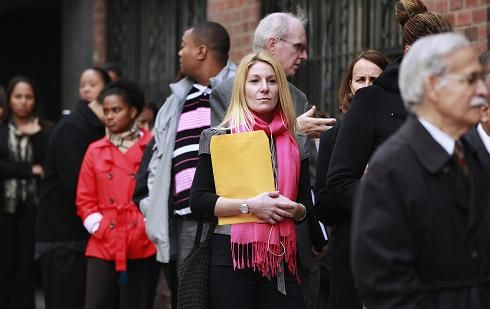US February Jobs Report 2013: Higher Taxes, Sequester Likely Weighed On Hiring; Unemployment Rate Seen Holding At 7.9%

Job growth in the U.S. was probably moderate in February, restrained by higher taxes and fears of deeper government spending cuts, economists said in anticipation of the government’s employment report due Friday. The unemployment rate likely remained unchanged from the prior month, which suggests that the U.S. Federal Reserve will be in no hurry to end its bond-buying program.
Economists polled by Reuters expect nonfarm payrolls to show a gain of 160,000 jobs in February, which would leave employment growing at much the same pace as in recent months. Over the past six months, employment growth averaged 177,000 per month.
While the trends in initial jobless claims have been moving largely sideways, continuing claims have shown a more encouraging trend, which is consistent with moderate payroll growth.
The Labor Department will release the February jobs data on Friday at 8:30 a.m. EST.
“There are more headwinds and fewer tailwinds than usual this first quarter compared to the last couple of first quarters,” said Sam Wardwell, Investment Strategist at Pioneer Investments.
Last week, the government confirmed that the U.S. economy grew just barely in the last quarter of last year, eking out a growth rate of 0.1 percent, which is basically indistinguishable from no growth at all and is far below the growth needed to get unemployment back to normal.
This year started out with considerable fiscal constraints. On Jan. 1, a two percent payroll tax cut ended and tax rates went up for top income earners. In addition, the economy is also facing $85 billion in across-the-board budget cuts, known as sequestration, which started taking hold on March 1 and may have discouraged businesses from hiring.
Bank of America Merrill Lynch economists think there were some sequester-related job freezes in both the federal government and the private sector last month. Economists, on average, expect a loss of 7,000 government jobs in February, following a drop of 9,000 in January.
“We expect that construction and service sector activity will be the primary driving forces behind payroll growth, with modest gains in the manufacturing sector roughly offsetting declines in government employment,” Michael Gapen, senior U.S. economist for Barclays Capital, wrote in a note to clients.
It took the U.S. two-and-a-half years to gain back all the jobs lost from the 1990-91 recession, four years to recoup all the jobs lost after the 2001 recession, and the current round of recovery is already the longest since the end of World War II.
Without a meaningful acceleration in jobs growth, the unemployment rate will likely remain stuck at 7.9 percent in February.
The Congressional Budget Office’s latest estimate suggests that the natural unemployment rate is between 5.5 percent and 6.0 percent. However, the rate of unemployment in the U.S. has exceeded seven percent for 50 consecutive months, giving the Fed ammunition to continue on its loose monetary policy path.
The U.S. central bank in January said asset purchases, known as quantitative easing, will continue until there’s a significant improvement in the labor market, and set a target for an unemployment rate of roughly 6.5 percent.
Federal Reserve Chairman Ben Bernanke told lawmakers last week during his semiannual testimony on monetary policy that the U.S. jobless rate is unlikely to reach more normal levels for several years.
Responding to one lawmaker’s question about when the economy might produce enough jobs to bring the unemployment rate down to six percent -- the top of the Fed's long-term forecast range, Bernanke said: “A reasonable guess for six percent would be around 2016, about three more years.”
The Fed is buying $85 billion in bonds each month. Yet, minutes of the January Federal Open Market Committee meeting showed many officials had concerns over the risks presented by the central bank's policy course.
Bernanke downplayed the risks of expanding the Fed’s balance sheet, which, at $3.1 trillion, is almost four times its precrisis size. “We do not see the potential costs of the increased risk-taking in some financial markets as outweighing the benefits of promoting a stronger economic recovery and more-rapid job creation,” Bernanke said in prepared testimony.
While Wardwell, of Pioneer Investments, thinks the “Fed is pushing on a string,” he remains hopeful that the jobs market is gradually healing.
“When snow melts in the spring, spring doesn’t arrive all at once.”
© Copyright IBTimes 2024. All rights reserved.






















